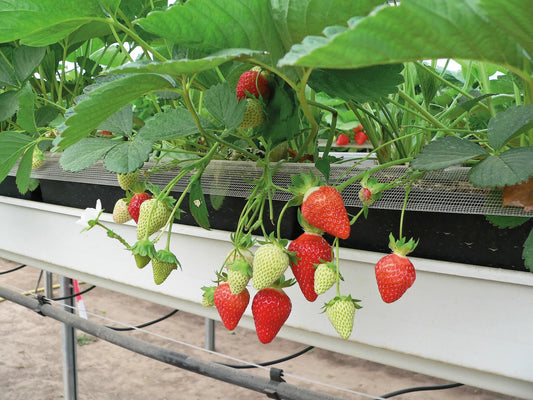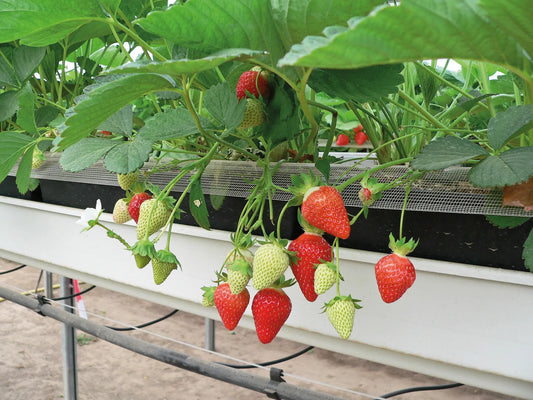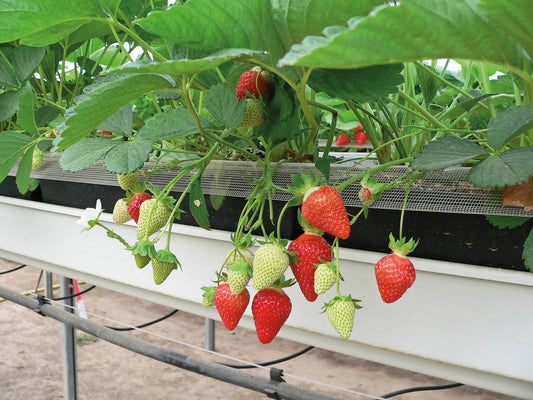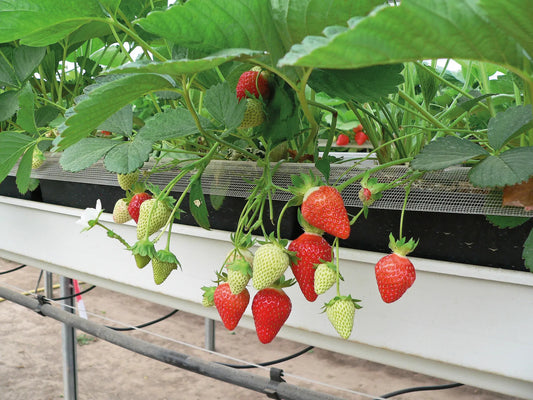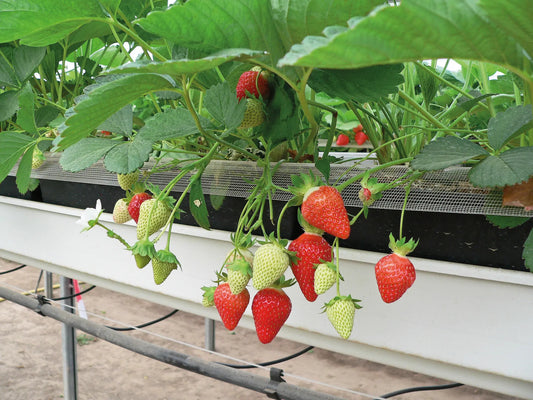-
Delivery from 10 plants to France, Switzerland and Europe
Delivery method -
Strawberry Plant Wholesale Supplier
About Us -
Quality Strawberry Plants
Strawberry technical itinerary -
Secure payment
Our Payment Terms
Murano Potted Strawberry Plant
Murano Potted Strawberry Plant
Price per unit (€ excluding VAT) excluding shipping. Our prices are based on volume. We offer you the best option based on your needs.
 - Add the desired date to your quote request
- Add the desired date to your quote request
- Buy now and get it delivered when you're ready to plant
- Delivery from 10 plants to France, Switzerland and Europe
Couldn't load pickup availability
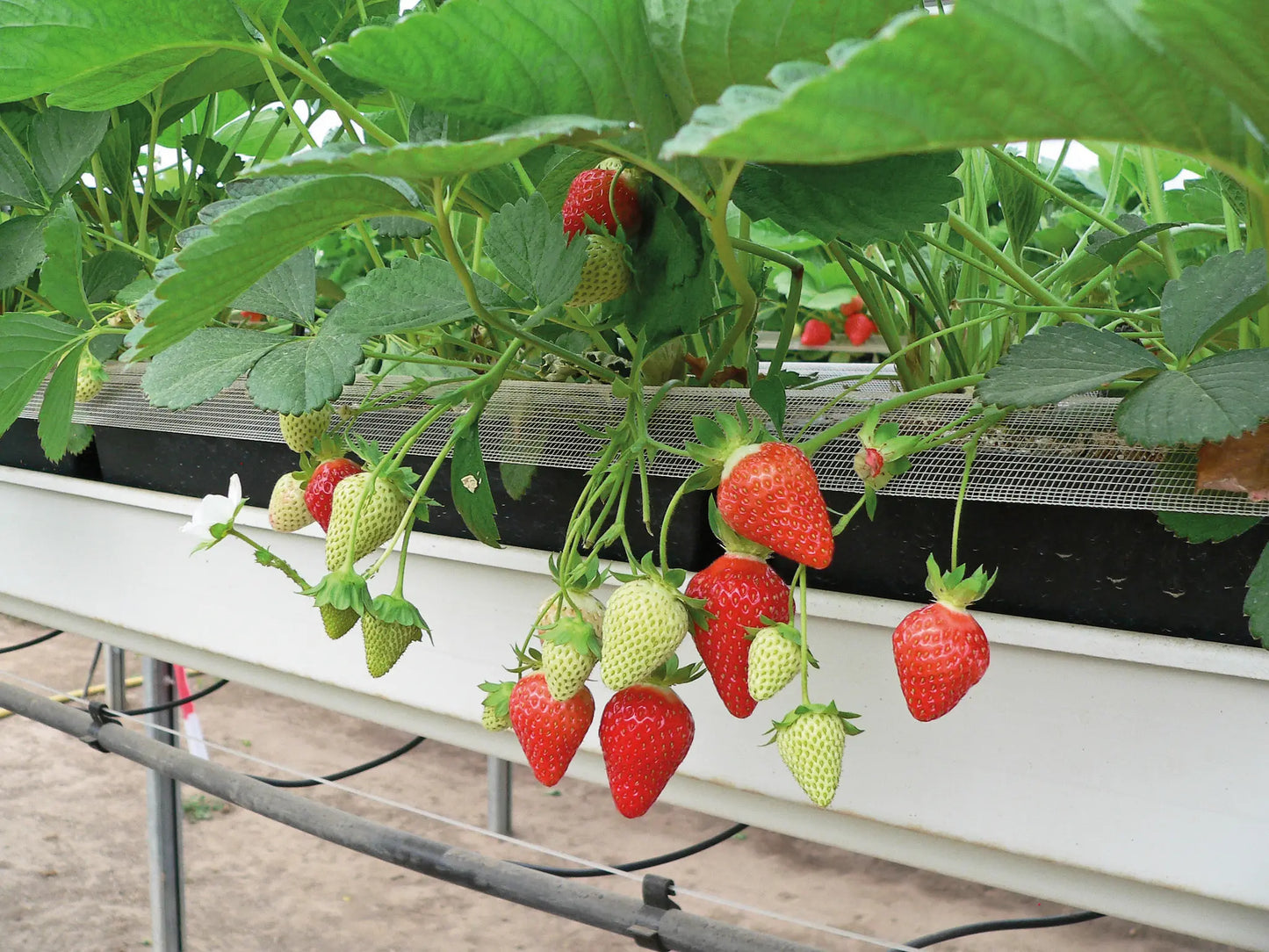
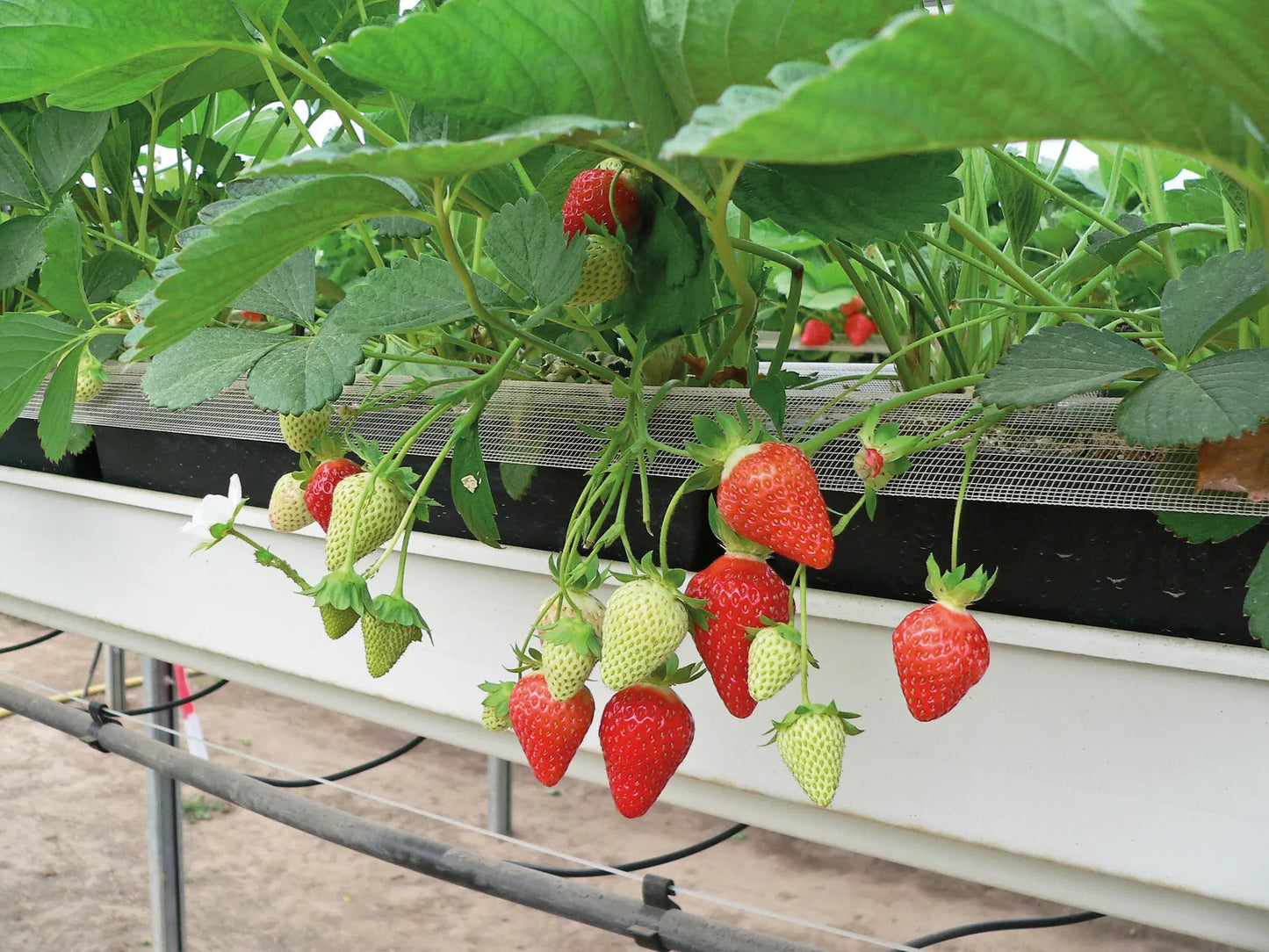
Collapsible content
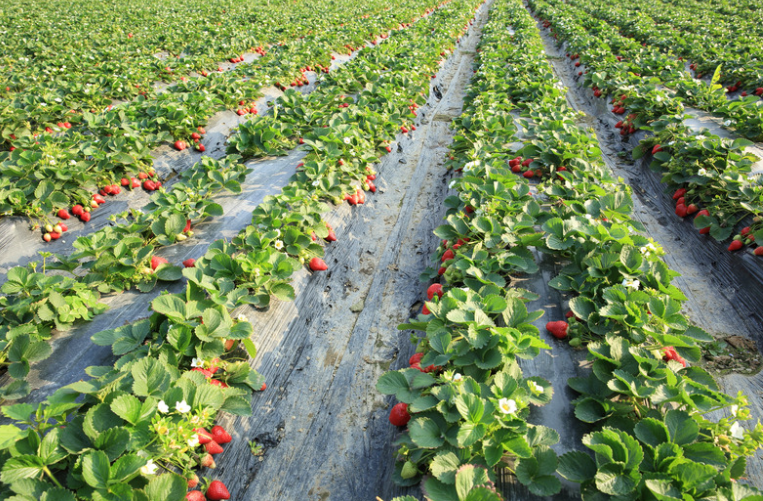
Strawberry Plant Buying Guide: What Type of Plants? For What Market Opportunity?
Which format should you choose: refrigerated, fresh, tray-plants, waiting bed, or plugs? Compare yields, costs, and harvest times at a glance.
Download the PDF guide (13 pages)
Why read this guide?
- Comparison tables: yield (300–600 g/plant), cost & labor.
- Reservation/delivery calendar for each format.
- Minimum order: 20 to 1,000 plants depending on the type.
- Full-field vs. above-ground case studies to maximize margin.
Overview of the 5 professional formats
Detailed comparison of formats
| Format | Yield (g/plant) |
Harvest time | Min. order | Average cost |
|---|---|---|---|---|
| Fridge | 250 – 400 | 120 days | 20 plants | 0.20 – 0.45 € |
| Costs | 280 – 420 | 140 days | 200 plants | 0.20 – 0.45 € |
| Tray plant | 400 – 600 | 90 days | 500 plants | 0.75 – 0.80 € |
| Waiting Bed | 300 – 500 | 105 days | 500 plants | 0.50 – 0.60 € |
| Motte | 230 – 350 | N+1 | 1,000 plants | 0.35 – 0.50 € |
Delivery schedule
| Plant type | Jan | Feb | Mar | Apr | May | Jul | Jul | Aug | Sep | Oct | Nov | Dec |
|---|---|---|---|---|---|---|---|---|---|---|---|---|
| Fridge | ||||||||||||
| Tray plants | ||||||||||||
| Waiting Bed | ||||||||||||
| Motte | ||||||||||||
| Costs |
Which format for which scenario?
Full field controlled budget
Fridge or Fresh : cost 2 x lower than tray plants, planting flexibility.
Above ground in greenhouse
Tray-plants : harvest 90 days after planting, uniform size, reduced labor.
Late planting
Mottes : planting July–August, rapid recovery, harvest the following year.
Ready to plan your plantings?
Download the complete guide Request a quoteFrequently Asked Questions
Is the guide free?
Yes, no fees or obligation to purchase.
How to download it?
Click the button “Download the guide” ; the PDF opens immediately.
Can I request a personalized quote?
Of course: write to us at contact@fraisiverse.com and an agronomist will respond to you within 24 hours.
Choosing the right strawberry varieties for your plot
Extend your harvest season by up to 5.5 months with our "early + season + everbearing" method. Compare 78 cultivars, sizes, and markets.
Download the PDF guide (17 pages)
4 axes to decide quickly
- Harvest Window : Early, Seasonal, or Everbearing? Combine them for 5.5 months .
- Commercial outlet : direct sales, long circuit, processing or freezing.
- Type of plants : fridge, fresh, root ball, tray plants… adapt your investments and your schedule.
- Growing conditions : open field, soilless, greenhouse; target consistent yield and size.
Axis 1: Select your harvest window
Example of recommended mix:
- Ciflorette (early) → Rubis des Jardins (season) → Charlotte (remontant).
- 5.5 months of continuous production, ideal for direct sales.
Axis 2: Sell at the right market
Direct sales
Ciflorette, Charlotte, Mara des Bois: premium taste sought after by consumers.
Long circuit / GMS
Magnum, Clery, Dream: uniform size, 95% class 1 fruit.
Transformation
Darselect, Mara des Bois – high sugar content and stable aroma.
Freezing
Honeoye, Belrubi – firm flesh, keeps well in the cold.
Axis 3: Choose the right type of plants
| Kind | Reservation | Delivery | Highlights |
|---|---|---|---|
| Fridge | All year round | Dec. → Aug. | Flexibility & price |
| Tray plants | Feb. → June | Nov. → Apr. | Above ground, harvest 90 days after planting |
| Motte | Sep. → May | Jul. → Sep. | Ideal for open fields, harvest N+1 |
| Costs | Feb. → Aug. | Sep. → Nov. | Young plants, rapid recovery |
Axis 4: Optimize your technical constraints
Tray plants guarantee +25% yield and simplified harvesting above ground; ideal for mechanizing your production and ensuring consistent size.
Frequently Asked Questions
Is the guide really free?
Yes, with no cost or obligation to purchase.
How to download it?
Just click the button “Download the guide” at the top of the page; the PDF opens immediately.
Can I request a personalized quote?
Of course: contact us via our contact page .
When to plant? When to harvest?
Do you want to start a strawberry farm but don't know when to reserve your plants, when to plant them or even harvest them?
Because we love 🍓 (with just a little sugar), we're going to do the work for you. On this page, you'll find the growing steps for each type of strawberry plant. When to order? What is the delivery period? When to plant? And finally, when to harvest?
Production Calendar - Frigo Strawberry Plants
| Production Calendar - Frigo Strawberry Plants | ||||||||||||||||||||||||
|---|---|---|---|---|---|---|---|---|---|---|---|---|---|---|---|---|---|---|---|---|---|---|---|---|
| Jan | Feb | Mar | Apr | May | Jun | Jul | Aug | Sep | Oct | Nov | Dec | |||||||||||||
| Reservation | ||||||||||||||||||||||||
| Deliverable | ||||||||||||||||||||||||
| Recommended planting | ||||||||||||||||||||||||
| Harvest | ||||||||||||||||||||||||
Production Calendar - Fresh Bare-Root Strawberry Plants
| Production Calendar - Bare Root Strawberry Plants | ||||||||||||||||||||||||
|---|---|---|---|---|---|---|---|---|---|---|---|---|---|---|---|---|---|---|---|---|---|---|---|---|
| Jan | Feb | Mar | Apr | May | Jun | Jul | Aug | Sep | Oct | Nov | Dec | |||||||||||||
| Reservation | ||||||||||||||||||||||||
| Deliverable | ||||||||||||||||||||||||
| Recommended planting | ||||||||||||||||||||||||
| Harvest | ||||||||||||||||||||||||
Production Calendar - Strawberry Plants Plugs
| Production Calendar - Strawberry Plants Motte | ||||||||||||||||||||||||
|---|---|---|---|---|---|---|---|---|---|---|---|---|---|---|---|---|---|---|---|---|---|---|---|---|
| Jan | Feb | Mar | Apr | May | Jun | Jul | Aug | Sep | Oct | Nov | Dec | |||||||||||||
| Reservation | ||||||||||||||||||||||||
| Deliverable | ||||||||||||||||||||||||
| Recommended planting | ||||||||||||||||||||||||
| Harvest | ||||||||||||||||||||||||
Production Calendar - Strawberry Plant Tray
| Production Calendar - Strawberry Plants Motte | ||||||||||||||||||||||||
|---|---|---|---|---|---|---|---|---|---|---|---|---|---|---|---|---|---|---|---|---|---|---|---|---|
| Jan | Feb | Mar | Apr | May | Jun | Jul | Aug | Sep | Oct | Nov | Dec | |||||||||||||
| Reservation | ||||||||||||||||||||||||
| Deliverable | ||||||||||||||||||||||||
| Recommended planting | ||||||||||||||||||||||||
| Harvest | ||||||||||||||||||||||||
Our Growing Guides by Plant Type / Our Growing Tips
Our online advisor: Fraisibot
Our technical itineraries by type of strawberry plant:
Technical Itinerary for Growing Strawberries from Frigo Plants
Technical Itinerary for Growing Strawberries from Plug/Pod Plants
Technical Instructions for Growing Strawberries from Tray or Mini Tray Plants
Technical Guide for Growing Strawberries from Bare-Root Fresh Strawberry Plants
Technical Instructions for Growing Strawberries from Waiting Bed Plants
All our growing tips for planting strawberries:
Strawberry Plants: Soil Preparation and Planting
Soil preparation for strawberry growing, planting techniques, and optimizing strawberry yield.
Best Practices for Irrigation and Fertilization of Strawberry Plants
Efficient irrigation systems, frequency and quantity of watering, types of fertilizers and application times, signs of nutritional deficiencies, growing strawberries in substrate, protection against frost and diseases.
Protection and Prevention of Strawberry Diseases and Pests
The main diseases and pests affecting strawberries, as well as effective methods for their prevention and treatment, including biological control and the use of resistant varieties. It provides practical advice for maintaining healthy and productive strawberry crops.
Succeeding in Strawberry Farming: Costs, Business Strategy and Subsidies
Growing strawberries requires significant initial and ongoing costs, but with effective marketing strategies and sustainable practices, growers can maximize their profits while contributing positively to the environment. Grants and financial aid are available to support necessary investments and encourage environmentally friendly farming practices.
Maximizing Strawberry Harvest and Storage: A Practical Guide
How to determine the optimal time to harvest strawberries, best practices for minimizing fruit damage during picking, and effective methods for storing and managing unsold strawberries to avoid losses and maximize profitability. It offers practical tips for extending the shelf life of strawberries, including refrigeration, freezing, and dehydration.
Strawberry Growing: Why Stagger Production? Early, Seasonal, Late? How to Choose?
Staggering strawberry production allows for harvests to be spread throughout the season, ensuring optimal fruit quality and increased profitability. Learn about recommended varieties for early, mid-season, and late-season production, as well as best practices for harvesting and storage.
Murano strawberry variety technical sheet
- Remontant: Remontante
- Earliness: Remontante
- Harvest period: All year round depending on floral induction and planting period by successive period (remontant) and type of plants
- Shape, texture, appearance of the Fruit: Large, uniform fruits
- Fruit color: Bright light red
- Taste characteristics: Perfect sugar/acid balance
- Fruit Size: Perfect sugar/acid balance
- Disease resistance: Very good disease resistance. Great firmness even in hot greenhouses.
- Yield, management and marketing: Very productive. Beautiful presentation in trays.
- Recommended commercial use / marketing channel: Direct sales, Wholesale, Processing
Order your professional strawberry plants
Fraisiverse, a specialist wholesale supplier of strawberry plants , offers you the Murano variety, renowned for its continuous productivity and exceptional firmness. Buying your strawberry plants is the first step to guaranteeing high yields and impeccable quality on your shelves. Our plants come from specialized nurseries, offering consistent professional quality and varietal resistance appreciated by producers. Take advantage of our producer prices and fast, careful delivery throughout France . Our responsive sales department and dedicated technical support support you with personalized advice to optimize your crops. Whether you are aiming for direct sales, short circuits or large-scale distribution, the Murano variety guarantees you regular and attractive fruits all season long. Order now or request a free quote to secure your supply.
Agronomic Profile and Varietal Characteristics
The Murano Strawberry is a remontant variety , meaning it is capable of producing fruit continuously throughout the season, guaranteeing a long-term supply for professionals. The plant, with its remarkable vigor , adopts a shape that facilitates harvesting and cultural management.
Morphological and Organoleptic Qualities of the Fruit
Regarding the fruit, the Murano stands out for its particularly neat visual appearance . Its external color varies from light red to orange-red, and it displays a brilliant shine that immediately catches the eye on the stalls. The shape of the fruit is conical , of exemplary regularity and homogeneity, essential qualities for packaging and commercial promotion. Its skin is smooth and without major defects, reinforcing this impeccable presentation.
The size of the fruit is a major asset, being medium to large, with an average weight generally between 20 and 25 grams . It is not uncommon to observe fruits reaching up to 35 grams when growing conditions are optimal, thus offering a very interesting weight yield. The firmness of the flesh is remarkable, even under the constraints of hot greenhouses, ensuring excellent resistance to transport and prolonged conservation, decisive criteria for downstream logistics. Inside, the pulp is a deep red, dense, juicy and fleshy, with a pronounced aroma that retains all its appeal when cut, making it ideal both for fresh consumption and for processing. On the palate, Murano offers a marked crunch and a dense texture, providing a pleasant resistance under the tooth, accompanied by a perfect balance between sugar and acidity.
Technical Itinerary and Cultural Conduct
Pedoclimatic Requirements and Soil Preparation
To fully exploit the potential of the Murano Strawberry, the choice and preparation of the soil or substrate are essential. This variety thrives ideally in slightly loamy or sandy loam soil , characterized by its flexibility and excellent drainage. It is imperative to avoid heavy, clayey and compact soils, as excess stagnant moisture could seriously compromise the plant's root system.
The soil pH should be neutral to slightly alkaline, with an ideal range of 6.5 to 7.5 . Acidic soils (pH below 6) should be avoided due to their negative impact on plant growth and health. A significant amount of organic matter is also essential; incorporating compost or well-rotted manure a few weeks before planting is highly recommended to promote nutrient availability throughout the growing cycle.
Soilless Cultivation Systems and Facilities
In soilless cultivation, a quality organic substrate , such as peat or coconut fiber, is recommended to ensure optimal root aeration (air porosity of at least 25%) and adequate water retention (around 60%). Planting plants on mounds or in raised beds is a relevant practice to limit the risks of water stagnation, and the minimum depth of the water table should ideally be greater than 1.5 meters. Mulching, whether straw or agrotextile fabric, is also recommended to keep the soil cool and preserve its structure.
Reasoned Fertilization Program
Regarding fertilization, Murano, as a highly productive remontant variety, has specific needs . On average soil and for intensive cultivation aiming for high yield, an annual nitrogen (N) supply of 100 to 140 units per hectare is recommended, divided into several applications: approximately 30% before planting (basal fertilization), 30% during vegetative recovery, and the remaining 40% during flowering and fruiting. For phosphorus (P₂O₅), a dose of 80 to 100 units per hectare is suggested, entirely applied during soil preparation. As for potash (K₂O), essential for fruit quality, a quantity of 150 to 180 units per hectare is recommended, with 40% as a basal fertilization and the remainder divided between vegetative recovery and flowering/fruiting. A magnesium (MgO) supply of 30 to 50 units per hectare is also necessary, and regular monitoring of trace elements such as boron, zinc, iron and manganese is essential, with additional inputs if deficiencies are detected by soil analysis. It is crucial to avoid excess nitrogen, which could harm the taste quality of the fruit. A high water requirement, particularly during fruit growth, justifies regular watering.
Yield Performance and Harvest Scheduling
Production Potential and Optimal Densities
The Murano Strawberry is an everbearing variety par excellence , which gives it a continuous production capacity over a very long period, allowing for a spread and regular marketing of the fruit. This characteristic is a major asset for professionals wishing to ensure a constant supply of their markets.
In terms of yield, the figures are particularly promising. When grown under soilless substrate with optimized systems, Murano can reach up to 1.4 kg of fruit per plant over a season. For open-field or plasticulture cultivation, a yield of 0.8 to 1.2 kg per plant is generally observed, depending on cultural practices (planting date, type of plant, fertilization and flowering management).
Projections of Yields per Hectare
These performances translate into impressive yields per hectare . With typical planting densities of 45,000 to 55,000 plants per hectare, the theoretical production potential is between 36 and 77 tonnes per hectare . In practice, most professional productions in France can reasonably aim for a range of 40 to 60 tonnes per hectare, taking into account climatic variations and the cropping system.
Although Murano produces medium-sized fruits, weighing an average of 18 to 20 grams , careful management of the flower load is recommended to maintain optimal size, as excessive flowering could reduce it. The fact that Murano is a remontant variety means that its production is not concentrated in a short period like non-remontants; rather, it offers a staggered harvest throughout the season, allowing growers to adapt to market demands throughout the year.
Phytosanitary Management and Varietal Resistance
Tolerance to Major Pathologies
The Murano strawberry is particularly appreciated for its very good general resistance to the main foliar and root diseases of the strawberry. In particular, it displays excellent tolerance to common and devastating pathologies such as powdery mildew (Podosphaera aphanis), botrytis (grey mold), anthracnose and phytophthora (red crown). This varietal robustness is a major economic and environmental asset for professional producers, as it significantly reduces the dependence on phytosanitary treatments for the management of these diseases.
Sensitivities and Points of Vigilance
However, it is important to note that while Murano offers a high general disease tolerance, it does not have specific and proven genetic resistance to Xanthomonas fragariae (angular leaf spot), and its susceptibility is considered low to moderate compared to reference varieties. Like most commercial varieties of Fragaria x ananassa, it is susceptible to this bacterium to some extent. Therefore, special vigilance and appropriate cultural practices are necessary in the presence of this pathology.
Integrated Pest Management Strategies
Regarding common strawberry pests, such as thrips, aphids, spider mites (mites), the weevil (Anthonomus rubi) and Drosophila suzukii, there are no documented data indicating specific genetic resistance for the Murano variety. Thus, for these pests, health management is based on the application of integrated pest management protocols . This involves regular monitoring of pest populations, the implementation of biological control methods (e.g., the use of ladybugs, entomopathogenic nematodes or predatory bugs), as well as the adoption of good cultural practices (crop rotation, optimal aeration of plants, removal of plant debris and infestation sources).
Economic Optimization and Commercial Logistics
Valuation and Distribution Channels
The Murano strawberry variety is an eminently profitable choice for professionals, with its primary commercial use being for fresh consumption. Its intrinsic qualities make it a highly valuable variety, whether for direct sales at markets, through short supply chains, or for wholesale and supermarket distribution.
Post-Harvest Properties and Storage
Supply logistics are greatly facilitated by the fruit's exceptional characteristics : proven firmness that guarantees excellent transport resistance and very good preservation, even under hot greenhouse conditions. This resilience significantly reduces post-harvest losses and ensures impeccable presentation of the strawberries in punnets, an essential criterion for the fresh market. The uniform size of Murano, generally between 18 and 20 grams, contributes to this highly sought-after homogeneous presentation. Its resistance to picking injuries is also above average, minimizing damage during harvest. The measured firmness is typically between 1.8 and 2.4 kg/cm² , which positions it as a reference for fruits with a marked crunch.
Logistical Advantages and Production Flexibility
Murano's ability to produce continuously throughout the year, depending on management techniques (type of plants, floral induction), is a major logistical asset . It allows producers to guarantee a regular presence on the stalls and to adapt to fluctuations in demand, thus optimizing the value of volumes. The fruits are mainly sold in 250 to 500 gram trays .
Although its use for processing (jam, frozen) is possible thanks to its firmness and yield, this is not its priority. Its maximum value is achieved in the fresh segment, where its taste quality (sugar/acid balance) and presentation give it significant added value. The Murano strawberry plant represents a significant weight in French professional sectors, and is the subject of regular imports of certified plants from Italy, Spain and Morocco, demonstrating its preponderant place on the market.
Field Feedback and Professional Validation
Producer Qualitative Evaluations
Growers who have chosen the Murano Strawberry Plant report great satisfaction , highlighting the perfect balance between high productivity and consistent taste and visual quality. The Murano has proven to be "fruitful and tasty" , able to withstand adverse climatic phenomena such as heat, drought or prolonged rain, while maintaining excellent immunity to diseases. This robustness considerably reduces the need for phytosanitary treatments, which is a significant economic and ecological advantage for farms concerned with sustainable, even organic, agriculture.
Observed Commercial Performance
The vigor of the plant, combined with the firmness and productivity of the fruit, is a recurring strong point in feedback. Professionals particularly appreciate the "very good presentation in the tray" and the "great consistency of size throughout the season" , qualities that facilitate marketing and packaging. The Murano's ability to maintain "very good firmness even in hot greenhouses" is also a decisive criterion, allowing flexible harvest management without compromising fruit quality. In short, the Murano is acclaimed for its ability to provide a high yield of top-quality strawberries throughout the year, thus meeting the requirements of the most demanding markets. The "high rate of marketable fruit" confirms its economic interest for professionals.
To summarize: Our Murano Strawberry plants
At Fraisiverse , we offer you the Murano variety, appreciated for its continuous production, its remarkable firmness and its high yield. As a specialist wholesale supplier of strawberry plants , we guarantee a supply of certified plants, from specialized nurseries, for efficient and sustainable plantations. Choosing our offer means buying Murano strawberry plants with the guarantee of professional quality and consistency of size throughout the season. The Murano variety, capable of reaching up to 1.4 kg of fruit per plant in optimized cultivation, offers a potential of 40 to 60 tons per hectare. Its very good tolerance to powdery mildew, botrytis and anthracnose reduces losses and limits treatments. Our role as a specialist wholesale supplier of strawberry plants is accompanied by a technical and commercial service to advise you on the choice of substrate, reasoned fertilization and phytosanitary management. By choosing to buy Murano strawberry plants from Fraisiverse , you benefit from a product adapted to demanding markets, which can be sold directly or in large-scale distribution. The consistency of quality, regularity of size and exceptional resistance to transport make Murano a strategic choice. Our expertise as a wholesale supplier specializing in strawberry plants guarantees you compliant plants, delivered quickly, ready to produce attractive and tasty fruits. To maximize your profitability and meet market expectations, choosing to buy Murano strawberry plants from us is a safe and profitable investment.
-
Murano Potted Strawberry Plant
Regular price €0,37 EURRegular priceUnit price / per -
Murano Frigo A- Strawberry Plant
Regular price €0,25 EURRegular priceUnit price / per -
Murano Frigo A++ Strawberry Plant
Regular price €0,40 EURRegular priceUnit price / per -
Murano Frigo A+ Strawberry Plant
Regular price €0,34 EURRegular priceUnit price / per -
Murano Frigo A Strawberry Plant
Regular price €0,31 EURRegular priceUnit price / per






